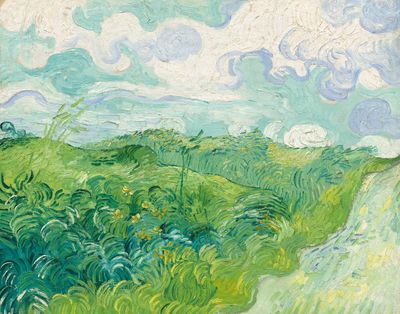National Gallery displays rarely seen Van Gogh

WASHINGTON – A Vincent Van Gogh painting that has been hidden away at a Virginia estate for decades will have a new home at the National Gallery of Art.
The rarely seen 1890 painting, “Green Wheat Fields, Auvers,” depicts a landscape in bright greens and blues from northern France when Van Gogh was living just north of Paris in Auvers-sur-Oise. The painting was given to the museum by philanthropist and art collector Paul Mellon, and it has been kept in his family’s home in Upperville, Va., since 1955.
It went on display last week alongside five other Van Gogh paintings. The museum now holds nine altogether.
The painting has only been exhibited once before in the United States in a show devoted to the Mellon collection in 1966 at the National Gallery of Art. The painting spent its early years with Van Gogh’s brother Theo and then was traded in Germany. It was shown in a major exhibition in Cologne, Germany, in 1912 and then in Berlin. But it has mostly been out of view since the 1930s, said French paintings curator Mary Morton.
The painting was created while Van Gogh was struggling. He had cut off his earlobe on Christmas Eve in 1888 and committed himself to an asylum in southern France a few months later before he returned to northern France and turned to painting spectacular landscapes.
“It’s really one of the great landscapes of that moment. It is in very good condition,” Morton said, adding that it retains the thick paint and expressive, emotional brush strokes that Van Gogh became famous for. “This is why we love him so much.”
It’s likely impossible to pinpoint when this painting was created. It’s not dated. But it is part of a group of paintings he likely completed in June or July 1890 before his death in late July. There’s no way to know what his final painting was, Morton said.
While there are multiple Van Gogh exhibitions around the world every year, this painting has never been part of those.
“What’s great about this picture is that it really is just a field painting. It’s just about grass and wind and sky,” Morton said. “It’s very sort of pure in that sense. There’s no story. There are no figures. There’s nothing to read. It’s just this feeling he has while he’s out there, and he’s completely absorbed by the environment.”